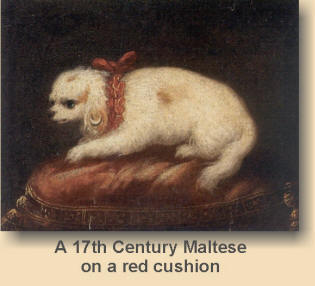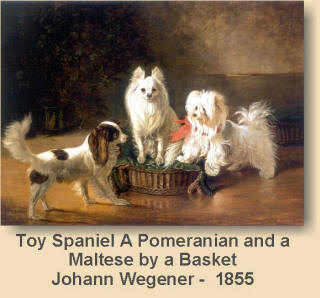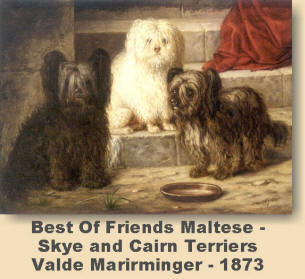The Maltese descends from one of the most
ancient dog breeds to be found in recorded history. It has been estimated that
the breed originated around 6,000 B.C., or 8,000 years ago. Although the ancient
Greeks and Romans believed the dog originated on the Island of Malta--they
called the breed the Melitaie Dog, Melitaie being the ancient name
for Malta--there is really no evidence that proves the dog was indigenous to the
Island, but rather that the Maltese is descended from a Spitz-type dog bred by
the peoples of the area which is now south central Europe. The breed was
eventually distributed as an exotic article of trade from the ancient island
trading center of Malta, hence the name, and from there migrated by caravans to
the farthest reaches of the civilized world, including: the Middle East, Tibet,
China, the Philippines, and Japan.
 The earliest known representations of Maltese dogs
on artifacts found at Fayum, Egypt (600-300 B.C.), suggest that the Maltese was
one of the dogs worshipped by the ancient Egyptians. Numerous pictorial
representations of the Maltese occur in Greek ceramic art, such as the vases
found at Vulci (about 500 B.C.), and the dog is mentioned in the writings of
many Greek and Roman philosophers, and other ancient poets and historians,
including: Aristotle, Timon, Callimachus, Aelian, Artimidorus, Epaminodus,
Martial, Strabo, Pliny the Elder and Saint Clement of Alexandria. Notable
ancient owners of Maltese include Roman Emperor Claudius and Publius, Roman
governor of Malta.
The earliest known representations of Maltese dogs
on artifacts found at Fayum, Egypt (600-300 B.C.), suggest that the Maltese was
one of the dogs worshipped by the ancient Egyptians. Numerous pictorial
representations of the Maltese occur in Greek ceramic art, such as the vases
found at Vulci (about 500 B.C.), and the dog is mentioned in the writings of
many Greek and Roman philosophers, and other ancient poets and historians,
including: Aristotle, Timon, Callimachus, Aelian, Artimidorus, Epaminodus,
Martial, Strabo, Pliny the Elder and Saint Clement of Alexandria. Notable
ancient owners of Maltese include Roman Emperor Claudius and Publius, Roman
governor of Malta.
 The Maltese emerged untarnished from the Dark Ages
and continued to be recorded as the dog prized by the upper class, aristocrats,
statespersons and royalty. The Maltese was even believed to possess medicinal
powers of healing--the ailing would place the dog on their stomach or chest for
comfort. Because of this practice, and the dogs warm, affectionate nature and
small size, which made it easy to hold in ones arms or lap, the Maltese became
known as the "Comforter." The dog was particularly popular in England during
Elizabethan times (the late 16th century). Two notable owners of Maltese in
those times were Queen Elizabeth I and Mary Queen of Scots.
The Maltese emerged untarnished from the Dark Ages
and continued to be recorded as the dog prized by the upper class, aristocrats,
statespersons and royalty. The Maltese was even believed to possess medicinal
powers of healing--the ailing would place the dog on their stomach or chest for
comfort. Because of this practice, and the dogs warm, affectionate nature and
small size, which made it easy to hold in ones arms or lap, the Maltese became
known as the "Comforter." The dog was particularly popular in England during
Elizabethan times (the late 16th century). Two notable owners of Maltese in
those times were Queen Elizabeth I and Mary Queen of Scots.
 Beginning
around the mid 1800's and into the early 1900's there was
great debate among the noted dog writers and dog authorities
concerning the question of "which dog family the Maltese
belonged". A large group, especially the dog fanciers
of England, felt that the Maltese belonged in the Terrier
family due to their terrier-like temperament. As
with the English terrier breeds, the Maltese of the period
was an excellent ratter and exhibited great fearlessness,
despite his small size. Others disagreed and felt that
the Maltese, because of his body and coat type, were spaniel
in nature. Ultimately, in the early 1900's, it was
concluded that the "Maltese dog" was neither terrier or
spaniel. Rather, he should correctly be referred to as
the "Maltese dog".
Beginning
around the mid 1800's and into the early 1900's there was
great debate among the noted dog writers and dog authorities
concerning the question of "which dog family the Maltese
belonged". A large group, especially the dog fanciers
of England, felt that the Maltese belonged in the Terrier
family due to their terrier-like temperament. As
with the English terrier breeds, the Maltese of the period
was an excellent ratter and exhibited great fearlessness,
despite his small size. Others disagreed and felt that
the Maltese, because of his body and coat type, were spaniel
in nature. Ultimately, in the early 1900's, it was
concluded that the "Maltese dog" was neither terrier or
spaniel. Rather, he should correctly be referred to as
the "Maltese dog".
Beginnings of Dog Shows
In 1862, 20 Maltese were exhibited
at a show in London. The Kennel Club (England) was
established in 1873. One of the first functions of
that body was to establish a stud book. The first
English stud book has twenty-four Maltese registered between
1859 and 1873. A very famous breeder from 1875 through
1885 was Lady Giffard, whose dogs were noted for their long
silky coats. Two of her most famous dogs were
four-pound "Hugh" and his litter sister, three pound "Queenie".
From 1902 to 1913 The Kennel Club
offered classes for Maltese dogs, other than white.
The first entry made under this classification was made in
1908 and the last was made in 1913. The colored
Maltese differed from the white variety. The English
standard for the Maltese called for the white variety not to
exceed 12 pounds. The colored variety could not exceed
8 1/2 pounds. All colors were admissible into the
colored classes. The white variety were required to be
pure white. Besides the size difference, there were
other variations between the two varieties. The
colored coats were coarser textured than the white coats.
The head of the colored Maltese tended to be shorter muzzled
and broader skulled than those of the white Maltese.
Maltese in the United States
The earliest known Maltese on
record in the United States was born in 1873. He was
entered at Westminster in 1879 and was also the first
colored Maltese shown here. Entered as a "Maltese Skye
Terrier," he was described as being white with black ears.
There was great interest in colored
Maltese in the United States. Some crossbreeding was
done here, as well as in England. One such recorded
crossbreeding used a white Maltese and a black Pomeranian.
The resultant litter produced black Maltese, identical to
the white variety.
The first white Maltese exhibited
was entered at the first Westminster show in 1877 as a
"Maltese Lion Dog." The first Maltese to be
registered in the American Kennel Club's Stud Book were two
bitches in 1888. They were: "Snips" - Origin unknown,
and "Topsy"-an import
From 1900 through 1910, there were
numerous Poodle kennels throughout America involved in
Maltese. Crossbreeding between these two breeds was
frequent and it is likely that the Maltese was used to lock
in the small size, color, and pigmentation. White Toy
Poodles were among the first acclaimed in the show ring.
Some of the undesirable results of those
crossbreedings have lingered to this day. The Toy
Poodle has difficulty with "round" eye instead of the almond
shaped eyes called for in their standard. On the
Maltese side of the issue, an incorrect "poodle-like" coat
texture can be found in some Maltese.
In 1901, two more bitches were
entered into the American Kennel Club Stud Book. In
1902, six Maltese were entered. It was not until the
1950's that 50 Maltese had been entered in the stud books.
In 1950 the Maltese breed ranked 76th among the all breed
registrations for that year. Since the 1950's the
Maltese has grown in popularity

